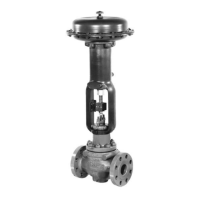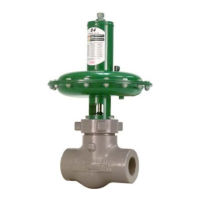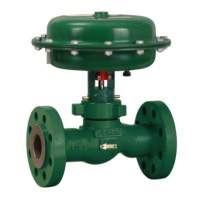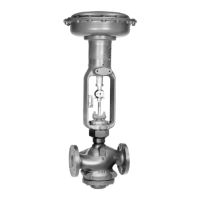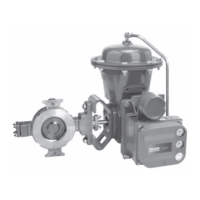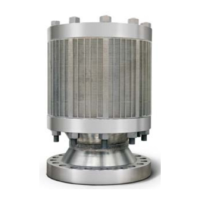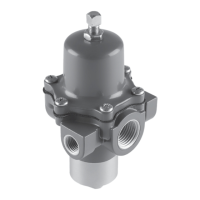Shutdown
To take the regulator out of operation:
1. If a bypass line is used, slowly open the
bypass line block valve while monitoring the
downstream pressure.
2. Close the control line shuto valve.
3. Close the downstream block valve.
4. Close the upstream block valve.
5. If a pressure-loaded or on-o pilot is used, close
the needle valve to the pilot.
6. Vent the regulator and control line to release any
trapped pressure.
Troubleshooting
Operating diculties may be experienced with this
valve as a result of improper installation, improper
valve sizing, damage to internal parts, trim wear or an
accumulation of dirt, boiler compound or other foreign
materials on internal parts. When trouble occurs,
check the following:
Type 92B
Build-up of Downstream Pressure
1. Check for plugged bleed tting (key 61, Figure 8).
2. Check the screen (key 77, Figure 9 or 10) for
clogging and the other pilot internal parts for
accumulation of dirt, boiler compound or
other materials.
Failure to Maintain Downstream Pressure
1. Check for ruptured diaphragm (key 60, Figure 8).
2. Check to see that the valve is not undersized.
Cycling or Hunting
Check to see that the valve is not oversized. A cycling
Type 92B might possibly control the downstream
pressure within acceptable limits but the life of the
diaphragms, guide bushings, seat ring and valve plug
could be greatly reduced.
If cycling occurs, as a result of oversizing or other
causes, it can frequently be minimized by reducing
the gain of the Type 92B. This can be accomplished
by installing a suitable reducing regulator such as
a Type MR95H in the Type 92B pilot supply line.
Adjust the pilot supply line regulator to reduce pilot
supply pressure to about 30 psig / 2.1 bar above the
outlet pressure setting of the Type 92B valve. This
arrangement can minimize cycling and still provide
adequate pilot supply pressure to ensure full opening
of the main valve plug, if required.
Note
The 30 psig / 2.1 bar is suggested for
units which include the standard 17-7 PH
stainless steel main spring. This spring
requires approximately 20 psig / 1.4 bar
diaphragm dierential pressure to fully
stroke the main valve. If the lighter rate
Inconel
®
spring is used, only about
10 psig / 0.69 bar diaphragm dierential
pressure is required to fully stroke the unit.
Therefore, the pilot supply pressure can be
reduced to about 20 psig / 1.4 bar above
the outlet pressure setting of the control
valve without loss of control capability.
Maintenance
CAUTION
Before disassembly or removing the
control valve from the line, isolate it
from the pressure system and release all
the pressure from the control valve.
Due to normal wear, parts must be periodically
inspected and replaced if necessary. The frequency of
inspection depends on the severity of the service.
Main Valve Disassembly
Type 92B
Key numbers listed are shown on the body assembly
drawing, Figure 8.
1. Remove all tubing.
2. Mark the outside edge of the body and diaphragm
case anges with assembly marks to ensure proper
assembly. Remove bolts from diaphragm case and
lift o the case. On cast iron body sizes NPS 1-1/2
through 4 / DN 40 to 100, rst remove the loading
tubing compression coupling tting from the
pipe nipple.
Inconel
®
is a trademark owned by Special Metals Corporation.
9
Type 92B

